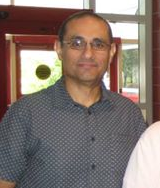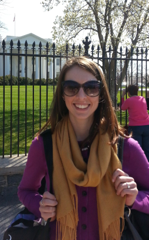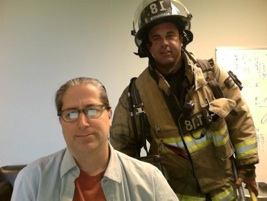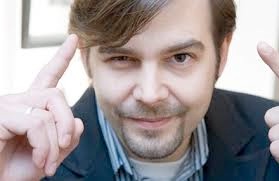- Overview
- EcoDevo - Biol 4370
- Evolution - Biol 3306
- Scientific Communication - Biol 6312
- Biology & Biochemistry Undergraduate Research Training (BURT) Program & Course (BIOL/BCHS 3396 & 4396; AKA Senior Research Project)
- Major Interest Group (IDNS 2197)
- (Award Winning!) GalapaGo! Research-Based Learning Abroad Program & Preparatory Course
- The Evolution and Development of Polyphenisms
- STEM Careers Seminar: And you may ask yourself, how did I get here?
- Houston Zoo Paid Summer Internship
Navigating the Many Roads to Success in the Life Sciences |
 |
A liberal arts degree that emphasizes hands-on training in the life sciences or other STEM (Science, Technology, Engineering & Mathematics) can serve as the foundation for a diversity of rewarding careers. The path each student takes entails many opportunities and choices; there is no singular route to success. We have invited speakers to talk about how they moved through their professional lives, starting with study in biology to eventually land a career in the life sciences. These informal talks will focus on how chance, preparation, work and fun interacted to bring them to where they are today. Each will talk about what they think they did right, what they might have done not so right, their current work and their plans for the future. Below, each of the speakers provides a brief profile and a link to their homepage. Talks start at 1pm in the Estess Library - the Honors College will provide pizza.
These People Chose Biology -
What Happened Next Will Astound You
Mike de la Flor - 12 September
Scientific illustration; Genetics / Biology & Biochemistry [CMB and BoBI] poster
 Mike earned a BS degree with concentrations in psychology and biology from the University of Houston. Then, prior to being admitted into the graduate program at UH, he worked as a medical illustrator and animator holding positions at Baylor College of Medicine and the University of Texas Health Science Center, before going on to establish his own medical illustration practice. He has published several books on medical illustration and animation, and presented his work around the world. He holds a current certification in medical illustration. Mike is currently a PhD graduate student at the University of Houston in Dr. Gregg Roman’s laboratory, where he studies the genetic and neural correlates of behavior using the fruit fly brain as a model.
Mike earned a BS degree with concentrations in psychology and biology from the University of Houston. Then, prior to being admitted into the graduate program at UH, he worked as a medical illustrator and animator holding positions at Baylor College of Medicine and the University of Texas Health Science Center, before going on to establish his own medical illustration practice. He has published several books on medical illustration and animation, and presented his work around the world. He holds a current certification in medical illustration. Mike is currently a PhD graduate student at the University of Houston in Dr. Gregg Roman’s laboratory, where he studies the genetic and neural correlates of behavior using the fruit fly brain as a model.
Related Links
Molecular Movies and Molecular Movies Toolkit has a gallery, sample molecular movies, tutorials, and free tools for creating molecular animations with Autodesk Maya. The tools/plugins offered require some knowledge of animation and or how to work in 3D programs.
Autopack has a gallery, various free tools/plugins with which to create molecular animations in different 3D programs like Autodesk 3ds Max, Autodesk Maya, Maxon Cinema4D, and Blender.
Molecular Flipbook is about a new stand alone program called Molecular Flipbook, a simple but powerful program for creating molecular animations. This program is geared for individuals that have no animation experience.
Janet Iwasa’s TED Talk is a great review about molecular animation and its applications in research and education. Molecular animation has been developed to the point where researchers can now carry out visualization experiments digitally. Further, molecular animations are being used to help biology students visualize complex 3D structures and processes.
AMI is the website for the Association of Medical Illustrators.
Dr. Jenn Asmussen - 3 October
Cancer; Setting, funding and achieving academic goals / Honors College poster
 Prior to graduate school, Dr. Asmussen completed her bachelor’s degree in biochemistry here at the University of Houston (UH). She participated in UH’s inaugural Summer Undergraduate Research Fellowship (SURF) program, studying the dimerization of ciliary neurotrophic factor in Dr. Dar-Chone Chow’s laboratory. She continued performing research in Dr. Chow’s laboratory in subsequent semesters, generating and optimizing crystal structures of -lactamase in complex with -lactamase inhibitor protein. While completing her doctorate at the University of California San Francisco (UCSF), Dr. Jennifer Asmussen made cancer cells explode; specifically, she made chronic myeloid leukemia (CML) cells explode. To achieve this, Dr. Asmussen selectively targeted CML cells with tyrosine kinase inhibitors (TKI), a class of compounds designed to inhibit the oncogenic tyrosine kinase responsible for the development of this disease. Her thesis studies focused on understanding oncogene addiction in CML. The theory of oncogene addiction refers to a cancer cell’s reliance on a particular genetic lesion or protein for continued survival. Her studies suggest that CML cell sensitivity to TKI therapy is dependent on a complex, kinetic interaction between the initiation of pro-apoptotic pathways and the restoration of pro-survival growth factor-receptor signaling. Currently, Dr. Asmussen is the Coordinator for Nationally Competitive Scholarships in the Office of Undergraduate Research at the University of Houston Honors College, helping undergraduate students to realize and achieve their career goals. She ultimately hopes to inspire and guide the next set of cancer exploding researchers to their future scientific endeavors.
Prior to graduate school, Dr. Asmussen completed her bachelor’s degree in biochemistry here at the University of Houston (UH). She participated in UH’s inaugural Summer Undergraduate Research Fellowship (SURF) program, studying the dimerization of ciliary neurotrophic factor in Dr. Dar-Chone Chow’s laboratory. She continued performing research in Dr. Chow’s laboratory in subsequent semesters, generating and optimizing crystal structures of -lactamase in complex with -lactamase inhibitor protein. While completing her doctorate at the University of California San Francisco (UCSF), Dr. Jennifer Asmussen made cancer cells explode; specifically, she made chronic myeloid leukemia (CML) cells explode. To achieve this, Dr. Asmussen selectively targeted CML cells with tyrosine kinase inhibitors (TKI), a class of compounds designed to inhibit the oncogenic tyrosine kinase responsible for the development of this disease. Her thesis studies focused on understanding oncogene addiction in CML. The theory of oncogene addiction refers to a cancer cell’s reliance on a particular genetic lesion or protein for continued survival. Her studies suggest that CML cell sensitivity to TKI therapy is dependent on a complex, kinetic interaction between the initiation of pro-apoptotic pathways and the restoration of pro-survival growth factor-receptor signaling. Currently, Dr. Asmussen is the Coordinator for Nationally Competitive Scholarships in the Office of Undergraduate Research at the University of Houston Honors College, helping undergraduate students to realize and achieve their career goals. She ultimately hopes to inspire and guide the next set of cancer exploding researchers to their future scientific endeavors.
Related Links
MEK-Dependent Negative Feedback Underlies BCR−ABL-Mediated Oncogene Addiction; Asmussen et al 2014 (data paper)
Chronic myeloid leukemia; Sawyers 1999 (review paper)
Mechanisms of BCR-ABL in the pathogenesis of chronic myelogenous leukaemia; Ren 2005 (review paper)
Second generation inhibitors of BCR-ABL for the treatment of imatinib-resistant chronic myeloid leukaemia; Weisberg et al 2007 (review paper)
Dr. Tony Frankino - 10 October
Evolution of form; Picking a mentor / Biology & Biochemistry [E&E and BoBI] poster
 Dr. Frankino earned his undergraduate degree in Biology at Illinois State University. In his undergraduate thesis project, he sought to predict the outcome of larval competition for food between a native and recently introduced species of mosquito. Teaching high school biology for one year proved that he was better suited to research, and so he returned to the lab of his undergraduate mentor and earned his Master’s degree studying geographic variation in reproductive tactics in a mosquito. For his PhD, he went on to Indiana University, where he studied the consequences of different reproductive strategies in lizards - spending the summers on the Lizard Ranch in California. After taking a year off mid-degree, he returned to IU with a change in research focus, studying the evolutionary ecology of tadpoles that express an odd, alternative developmental pathway by becoming cannibals under some circumstances. This time, his field work placed him in the Chiricahua mountains of Arizona, just north of Mexico. He held postdocs at the University of North Carolina, Princeton University and Leiden University in The Netherlands. While in Holland, he began his research on the evolution of morphology, working on first butterflies and currently at UH on fruit flies. In all of his research, Dr. Frankino has tried to include a strong travel component, allowing him to spend time in beautiful places under the guise of work. He has mentored nearly 100 undergraduates from every undergraduate college at UH; these talented students have gone on to become industry scientists, physicians, naturalists, and even professors themselves.
Dr. Frankino earned his undergraduate degree in Biology at Illinois State University. In his undergraduate thesis project, he sought to predict the outcome of larval competition for food between a native and recently introduced species of mosquito. Teaching high school biology for one year proved that he was better suited to research, and so he returned to the lab of his undergraduate mentor and earned his Master’s degree studying geographic variation in reproductive tactics in a mosquito. For his PhD, he went on to Indiana University, where he studied the consequences of different reproductive strategies in lizards - spending the summers on the Lizard Ranch in California. After taking a year off mid-degree, he returned to IU with a change in research focus, studying the evolutionary ecology of tadpoles that express an odd, alternative developmental pathway by becoming cannibals under some circumstances. This time, his field work placed him in the Chiricahua mountains of Arizona, just north of Mexico. He held postdocs at the University of North Carolina, Princeton University and Leiden University in The Netherlands. While in Holland, he began his research on the evolution of morphology, working on first butterflies and currently at UH on fruit flies. In all of his research, Dr. Frankino has tried to include a strong travel component, allowing him to spend time in beautiful places under the guise of work. He has mentored nearly 100 undergraduates from every undergraduate college at UH; these talented students have gone on to become industry scientists, physicians, naturalists, and even professors themselves.
Dr. Elizabeth Ostrowski - 31 October
Adaptive evolution / Biology & Biochemistry [E&E and BoBI] poster, alternate poster
 Dr. Ostrowski received her B.A. in Biology from the University of Virginia. As an undergraduate she worked on the ulcer-causing bacterium Helicobacter pylori. She also carried out research on chestnut blight, a fungus that devastated chestnut trees across North America in the early 20th century. Working at the Mountain Lake Biological Station, she isolated the fungus from chestnut trees and examined its growth rate to determine whether hypovirulent (i.e., less deleterious) strains were spreading in Virginia, as they had been in other parts of the chestnut range. Fascinated by the idea that disease-causing organims could evolve to be more or less dangerous to their hosts, she decided that she wanted to become an evolutionary biologist. She went on to obtain a Ph.D. in bacterial evolution and artificial life from Michigan State University. Still interested in evolution, but wanting to work on organisms that she could see, she decided to work with the social amoebae (aka slime molds) - amoebae that organize themselves into multicellular structures upon starvation and that exhibit self-sacrifice. Dr. Ostrowski is interested in understanding why organisms behave altruistically and how organisms like the social amoebae evolve and maintain these self-sacrificing behaviors. Dr. Ostrowski moved to Houston to work with these social amoebae, first as a postdoc at Rice University and later as a postdoc at Baylor College of Medicine. She joined the UH faculty in 2011, where she teaches two courses, Genetics and Programming for Biologists. Dr. Ostrowski enjoys working with undergraduates and helping them to experience biology by getting out into nature! Her lab hosts field trips each semester to isolate social amoebae from sites around Houston.
Dr. Ostrowski received her B.A. in Biology from the University of Virginia. As an undergraduate she worked on the ulcer-causing bacterium Helicobacter pylori. She also carried out research on chestnut blight, a fungus that devastated chestnut trees across North America in the early 20th century. Working at the Mountain Lake Biological Station, she isolated the fungus from chestnut trees and examined its growth rate to determine whether hypovirulent (i.e., less deleterious) strains were spreading in Virginia, as they had been in other parts of the chestnut range. Fascinated by the idea that disease-causing organims could evolve to be more or less dangerous to their hosts, she decided that she wanted to become an evolutionary biologist. She went on to obtain a Ph.D. in bacterial evolution and artificial life from Michigan State University. Still interested in evolution, but wanting to work on organisms that she could see, she decided to work with the social amoebae (aka slime molds) - amoebae that organize themselves into multicellular structures upon starvation and that exhibit self-sacrifice. Dr. Ostrowski is interested in understanding why organisms behave altruistically and how organisms like the social amoebae evolve and maintain these self-sacrificing behaviors. Dr. Ostrowski moved to Houston to work with these social amoebae, first as a postdoc at Rice University and later as a postdoc at Baylor College of Medicine. She joined the UH faculty in 2011, where she teaches two courses, Genetics and Programming for Biologists. Dr. Ostrowski enjoys working with undergraduates and helping them to experience biology by getting out into nature! Her lab hosts field trips each semester to isolate social amoebae from sites around Houston.
You can learn more about Dr. Ostrowski’s work at her webpage. If you would like to go with them into the field to collect slim moulds or are interested in undergraduate research (or both!), you can send her an email here. Finally, join the lab email list, to find out about when the next collecting trip is, here.
Intro to slime moulds, narrated by Jude Law with Portishead soundtrack:
Classic film of Dicty life cycle:
Here is the longer version of the main movie she showed during her talk:
Dr. Jokubas Ziburkus - 14 November
Neuromedical science/ Biology & Biochemistry [CMB and BoBI] poster, alternate poster
 Jokūbas Žiburkus is an Associate Professor of Biology and Biochemistry with expertise in neurophysiology, neuroimaging, and neuroanatomy. His laboratory studies neural circuit activity and animal behavior in pathophysiological models of epilepsy and neural hyper-excitability using electrophysiology, fast voltage-sensitive dye imaging, neuroanatomical techniques, and computational neuroscience based approaches.He seeks to determine the cellular and network mechanisms underlying neural hyper-excitability during formation of intractable childhood epilepsy called Dravet syndrome, following traumatic brain injuries, and in advanced forms of dementia. His research is currently sponsored by the Dravet Syndrome Foundation and Alzheimer’s Association. The Principal Investigator’s long-term research goals are to discover mechanisms that lead to neural hyperexcitability and neurodegeneration and to develop new effective methods to treat these disorders.
Jokūbas Žiburkus is an Associate Professor of Biology and Biochemistry with expertise in neurophysiology, neuroimaging, and neuroanatomy. His laboratory studies neural circuit activity and animal behavior in pathophysiological models of epilepsy and neural hyper-excitability using electrophysiology, fast voltage-sensitive dye imaging, neuroanatomical techniques, and computational neuroscience based approaches.He seeks to determine the cellular and network mechanisms underlying neural hyper-excitability during formation of intractable childhood epilepsy called Dravet syndrome, following traumatic brain injuries, and in advanced forms of dementia. His research is currently sponsored by the Dravet Syndrome Foundation and Alzheimer’s Association. The Principal Investigator’s long-term research goals are to discover mechanisms that lead to neural hyperexcitability and neurodegeneration and to develop new effective methods to treat these disorders.
Dr. Dan Frigo - 21 November
Nuclear receptors in disease and treatment / Biology & Biochemistry [CNRCS] poster
 Dr. Frigo earned his bachelor’s degree from the University of Notre Dame. There he was he was a high jumper on the University’s track and field team during the year and did undergraduate research during the summers at Argonne National Laboratory. This research was in the field of nuclear engineering with a specific focus on the recycling of spent fuel from nuclear reactors. After 1) becoming disenchanted with the government’s stance on nuclear energy and 2) the realization that becoming a professional high jumper was not a viable option, he switched his attention towards biomedical research. After graduating with a degree in biochemistry, Dr. Frigo moved on to obtain his Ph.D. from Tulane University within the Interdisciplinary Program in Molecular and Cellular Biology. There his dissertation centered on understanding how various environmental chemicals could affect our endocrine systems through previously unknown mechanisms. Realizing he was not as passionate about environmental work as he was about hunting down new signaling pathways, Dr. Frigo next moved on to Duke University Medical Center where he did a postdoctoral fellowship within the Department of Pharmacology and Cancer Biology. Here, he began his research on identifying driver signaling pathways in cancer, an area that has continued to be the major theme of his work here at UH. At UH, Dr. Frigo trains postdoctoral fellows, technicians, graduate and undergraduate students, emphasizing basic biomedical research that could be translated in the future to the clinic.
Dr. Frigo earned his bachelor’s degree from the University of Notre Dame. There he was he was a high jumper on the University’s track and field team during the year and did undergraduate research during the summers at Argonne National Laboratory. This research was in the field of nuclear engineering with a specific focus on the recycling of spent fuel from nuclear reactors. After 1) becoming disenchanted with the government’s stance on nuclear energy and 2) the realization that becoming a professional high jumper was not a viable option, he switched his attention towards biomedical research. After graduating with a degree in biochemistry, Dr. Frigo moved on to obtain his Ph.D. from Tulane University within the Interdisciplinary Program in Molecular and Cellular Biology. There his dissertation centered on understanding how various environmental chemicals could affect our endocrine systems through previously unknown mechanisms. Realizing he was not as passionate about environmental work as he was about hunting down new signaling pathways, Dr. Frigo next moved on to Duke University Medical Center where he did a postdoctoral fellowship within the Department of Pharmacology and Cancer Biology. Here, he began his research on identifying driver signaling pathways in cancer, an area that has continued to be the major theme of his work here at UH. At UH, Dr. Frigo trains postdoctoral fellows, technicians, graduate and undergraduate students, emphasizing basic biomedical research that could be translated in the future to the clinic.